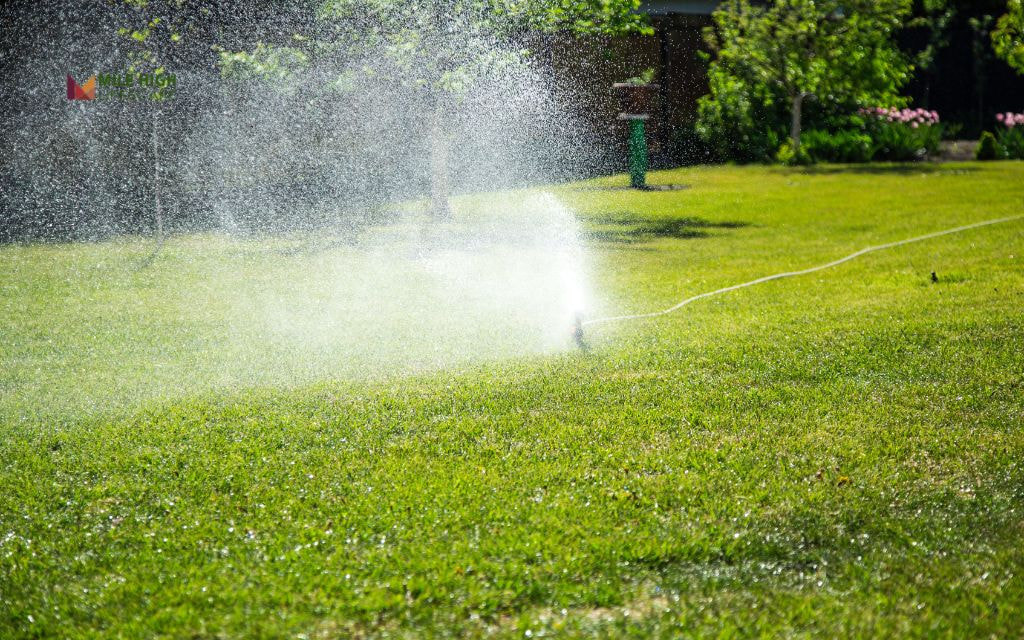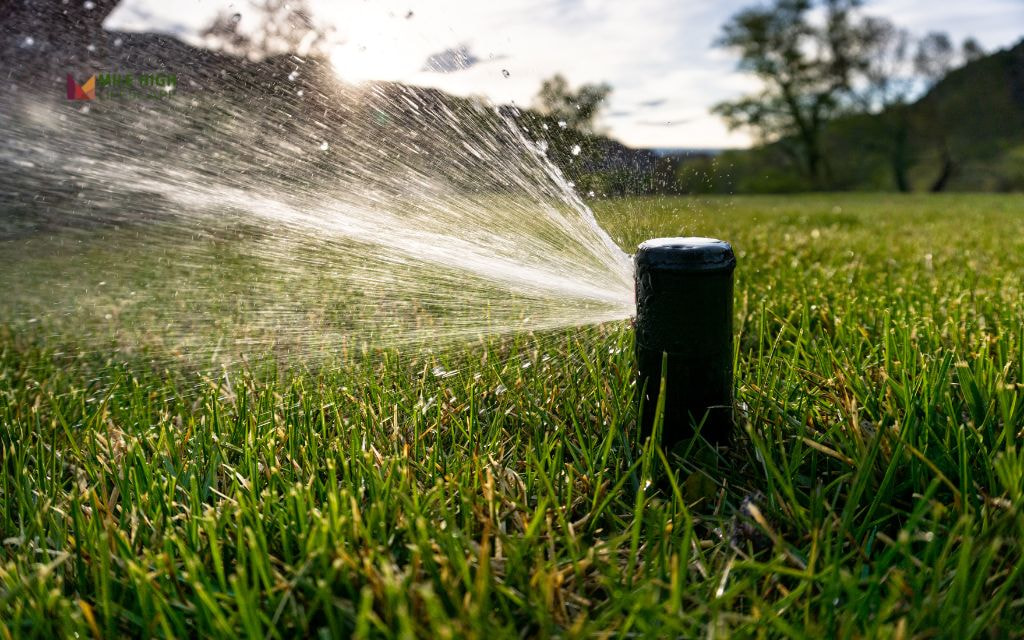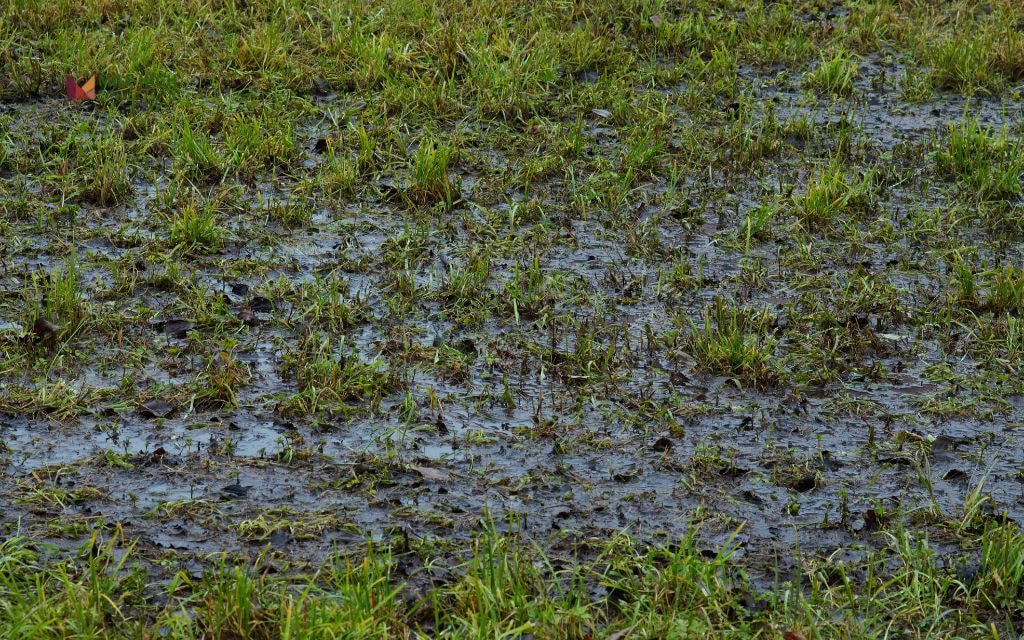If you’re a Denver homeowner, you know lawn watering is no simple task. Denver’s semi-arid climate, high altitude, and unpredictable weather patterns create challenges for maintaining a lush, green lawn.
The wrong approach to lawn watering can actually damage your grass, leaving it vulnerable to disease, pests, and drought stress. Many homeowners are either underwater, resulting in brown patches and thin turf, or overwater, which leads to shallow roots and fungal problems.
In this comprehensive guide, we’ll walk you through exactly when, how often, and how deeply to water your lawn in Denver’s specific climate. Let’s transform your lawn watering routine this season!
How Often Should You Water Your Lawn in Denver?
The golden rule for Denver lawn watering is to aim for 1–1.5 inches of water per week, combining both rainfall and irrigation. However, Denver’s unique climate requires special consideration when establishing a watering schedule.
Our mile-high altitude, abundant sunshine, and low humidity create higher evaporation rates than many other regions. This means Denver lawns typically dry out faster, requiring careful attention to watering schedules.
Wind exposure, slope, and shade also affect how quickly your lawn uses water—south-facing and sloped areas typically need more frequent irrigation than flat or partially shaded lawns.
Several environmental factors affect how frequently you’ll need to water:
- Slope: Water runs off sloped areas more quickly, potentially requiring shorter, more frequent watering cycles.
- Shade: Lawns in shaded areas retain moisture longer and may need less frequent watering.
- Wind exposure: Areas regularly exposed to wind experience faster evaporation and may need additional moisture.
- Soil type: Clay soils hold water longer, while sandy soils drain more quickly.
Best Time of Day for Lawn Watering
Early morning watering, between 6 AM and 10 AM, is ideal for several reasons.
First, wind speeds are typically lower, allowing for more even water distribution. Second, the morning sun helps dry the grass blades quickly, reducing disease risk.
Most importantly, morning watering minimizes evaporation loss while giving your lawn time to absorb moisture before the day’s heat intensifies.
For best results, follow these timing guidelines:
DO:
- Water between 6–10 AM for optimal absorption
- Adjust watering times seasonally
- Check local weather forecasts and skip watering before predicted rainfall
- Follow Denver Water restrictions during drought conditions
DON’T:
- Avoid watering after 6 PM to prevent fungal diseases
- Never water during midday (10 AM–6 PM) when evaporation is highest
- Don’t water during high winds, which cause uneven distribution
- Avoid watering frozen ground or when temperatures are below freezing

Best Watering Schedule for Lawn by the Season
Denver’s distinct seasonal changes require adjusting your lawn watering strategy throughout the year. Following these season-specific guidelines will help maintain a healthy lawn while conserving water:
Spring (March–May)
As your lawn emerges from winter dormancy, it needs consistent but moderate moisture to support new growth. Spring in Denver often brings unpredictable moisture, with wet snow and rain alternating with dry periods.
- Water 1–2 times per week depending on spring rainfall (reduce frequency after precipitation)
- Check irrigation systems and repair any damage from winter freezing
- Aerate your lawn in mid-spring to improve water penetration and reduce runoff
- Avoid watering before late frosts, as wet soil conducts cold more efficiently than dry soil
- Apply pre-emergent herbicides if needed, followed by thorough watering to activate
Summer (June–August)
Denver’s hot, dry summers create the highest water demand for lawns. Proper watering during this period is crucial for preventing drought stress while complying with city restrictions.
- Increase to 2–3 watering sessions per week, applying 30–40 minutes per zone
- Implement the cycle-and-soak method (two shorter cycles separated by 30-60 minutes) to avoid runoff, especially on slopes
- Water exclusively in early mornings to minimize evaporation and fungal disease risk
- Raise mowing height to 3–3.5 inches to shade soil and reduce evaporation
- Watch for signs of heat stress, including footprints remaining visible in grass or blue-gray color
Fall (September–November)
Fall watering is often overlooked but remains critical for root development before winter dormancy. Proper fall irrigation practices help ensure your lawn survives winter and thrives the following spring.
- Reduce watering to once weekly until first frost, tapering as temperatures cool
- Maintain consistent moisture during fall fertilization to support root growth
- Pay special attention to newly seeded or overseeded areas, which require more frequent, light watering
- Avoid watering when frost is expected in the next 24 hours
- Flush irrigation systems and prepare them for winterization by late October
Winter (December–February)
While lawns go dormant in winter, occasional watering during dry spells helps prevent winter desiccation, particularly in Denver’s low-humidity environment.
- Water 1–2 times per month only on days when temperatures exceed 40°F and no snow cover exists
- Water during midday (11 AM–2 PM) to allow absorption before overnight freezing
- Focus on south-facing and exposed areas that receive more winter sun and wind
- Pay special attention to new sod or recently seeded areas, which are more vulnerable to winter drying
- Disconnect and drain hoses after winter watering to prevent pipe freezing
Lawn Watering Techniques That Promote Deep Roots
Developing a deep, extensive root system is the key to creating a drought-resistant lawn in Denver’s challenging climate. These 9 techniques will help your lawn develop stronger roots while using water more efficiently:
- Water Deeply, Not Frequently: Apply more water less often to encourage roots to grow downward. This creates a lawn that can withstand Denver’s hot, dry periods by accessing moisture deeper in the soil. Aim for 1-1.5 inches of water per session rather than multiple shallow waterings.
- Implement Cycle-and-Soak Method: Instead of one long watering session, break it into 2 shorter cycles (e.g., 15 minutes, rest for 30 minutes, then another 15 minutes). This prevents runoff on compacted or sloped lawns and allows water to penetrate deeply.
- Use the Screwdriver Test: After watering, push a screwdriver into your lawn. It should penetrate easily to a depth of 6 inches. If not, your soil isn’t receiving enough moisture or may be compacted.
- Aerate Your Lawn Annually: Core aeration removes small plugs of soil, creating pathways for water, oxygen, and nutrients to reach the root zone. For Denver lawns, aerate in early spring or fall.
- Adjust for Slope: On sloped areas, reduce run times by 25-30% but increase the number of cycles to prevent wasteful runoff while ensuring proper soil saturation.
- Avoid Windy Day Watering: Wind disperses water unevenly and increases evaporation. Check weather forecasts and avoid watering on particularly windy days.
- Prevent Soggy Soil Conditions: Consistently saturated soil promotes shallow roots and fungal diseases. Allow the top 1-2 inches of soil to dry between waterings.
- Use Mulch Strategically: Apply mulch around trees, garden edges, and in landscape beds adjacent to lawn areas to reduce evaporation and maintain soil moisture.
- Tailor to Grass Type: Kentucky bluegrass (common in Denver) needs consistent, moderate watering, while tall fescue varieties have deeper root systems and may require less frequent watering.
Implementing these techniques will gradually transform your lawn into a more resilient, water-efficient landscape that can better withstand Denver’s periodic drought conditions.

Lawn Watering Tips for New Sod or Seeded Lawns
Establishing new lawns in Denver’s climate requires special watering attention. Whether you’ve installed sod or seeded your lawn, proper irrigation during the first 4-6 weeks determines long-term success.
New lawns have undeveloped root systems that can’t access deeper soil moisture, making them particularly vulnerable to Denver’s dry conditions.
- For new sod, the goal is to keep the sod and the soil beneath consistently moist while roots establish.
- For seeded lawns, you must maintain constant moisture in the top layer of soil until germination, then gradually train roots to grow deeper.
Follow these guidelines for successful establishment:
| Week | Frequency | Notes |
| Week 1 | 3–4x/day (sod) 4-5x/day (seed) | Short, light sessions to keep the surface consistently moist.
|
| Week 2–3 | 1–2x/day | Gradually increase watering duration while reducing frequency.
|
| Week 4+ | 2–3x/week | Transition to deeper, less frequent watering schedule. Begin normal lawn care practices, including first mowing when grass reaches 3-3.5 inches (never remove more than 1/3 of blade height). |
Additional tips for establishing new lawns in Denver:
- For sod, water immediately after installation—don’t wait until the next day
- During hot weather (above 85°F), increase watering frequency but not duration
- Watch for signs of water runoff and adjust sprinklers accordingly
- Avoid walking on newly sodded or seeded areas during establishment
- Apply a starter fertilizer according to package directions to encourage root development
- Consider installing new lawns during spring or fall when temperatures are cooler and evaporation rates are lower
Signs You’re Overwatering (or Underwatering)
Both overwatering and underwatering can damage your lawn, but they present different symptoms.
Signs of Overwatering
- Soft, spongy soil that feels constantly wet
- Fungal growth, including mushrooms or gray/white powdery patches
- Excessive thatch buildup (more than ½ inch)
- Yellowing grass that doesn’t respond to fertilizer
- Presence of weeds like nutsedge or crabgrass
- Water runoff onto sidewalks or driveways during irrigation
- Mosquito problems near your lawn
Signs of Underwatering
- Grass turns a blue-gray color before browning
- Visible footprints remain on the lawn for hours after walking on it
- Grass blades become brittle and don’t spring back when stepped on
- Soil is dry and hard several inches below the surface
- Lawn develops brown patches that don’t recover after watering
- Grass growth slows significantly
Two simple tests can help determine if your lawn needs water:
- Step Test: Walk across your lawn in the afternoon. If footprints remain visible after 30 minutes, the grass lacks adequate moisture and has lost resilience.
- Screwdriver Test: Insert a 6-inch screwdriver into the soil. If it penetrates easily, soil moisture is adequate. If it meets resistance, watering is needed. If it won’t penetrate at all, soil is severely dry.
Remember that Denver’s clay soils can appear dry on the surface while retaining moisture below, so visual inspection alone isn’t reliable. Always check soil moisture at root depth (about 6 inches) before adjusting your watering schedule.

When to Call a Lawn Care Professional for Watering Help
While many lawn watering issues can be addressed through proper techniques, some situations warrant professional intervention. Consider consulting Mile High Lifescape or another reputable Denver lawn care service if you encounter these challenges:
- Persistent brown patches that don’t respond to adjusted watering schedules may indicate irrigation system problems, soil issues, or lawn diseases requiring professional diagnosis
- Uneven watering patterns with some areas consistently dry while others remain soggy, suggesting sprinkler system inefficiencies or improper zoning
- Water runoff issues, particularly on slopes or compacted soils, which may require specialized solutions like drip irrigation, soil amendments, or improved drainage systems
- Irrigation system malfunctions including broken heads, leaking valves, or controller problems that waste water and damage your lawn
- High water bills without corresponding lawn improvement, potentially indicating underground leaks or inefficient system design
- New construction properties with poor soil quality, requiring comprehensive soil testing and amendment strategies
Professional services that can improve your lawn’s water efficiency include:
- Irrigation audits to assess system efficiency and distribution uniformity
- Smart controller installation that adjusts watering based on weather conditions
- Soil testing and amendment programs to improve water retention and drainage
- Custom watering schedules based on your specific grass type, soil conditions, and microclimate
Conclusion
Proper lawn watering in Denver requires balancing the unique challenges of our semi-arid climate with conservation goals and healthy turf practices.
By following the guidelines in this article – watering deeply but infrequently, choosing the right time of day, adjusting for seasonal changes, and using techniques that promote deep root growth—you’ll develop a lawn that’s both beautiful and resilient.
Remember that lawn watering isn’t just about keeping grass green; it’s about creating a sustainable landscape that can withstand Denver’s challenging conditions while conserving our precious water resources. Through proper timing, appropriate techniques, and responsive adjustments, you can maintain a healthy lawn with minimum water waste.
Frequently Asked Questions (FAQs)
How many minutes a day should I water my lawn?
In general, you should water your lawn twice a week for 20-30 minutes each time. This will provide your lawn with about 1 inch of water per week, which is the recommended amount for most lawns. However, the exact duration depends on your sprinkler system’s output, soil type, and current weather conditions.
What is the 1/2/3/2:1 lawn watering technique?
The 1-2-3-2-1 watering technique is a seasonal approach tailored to Denver’s climate: In April, water 1 day/week. In May, 2 times/week. During summer’s peak heat (June-August), water 3 times/week. In September, reduce to 2 times/week. In the fall, drop back down to 1/week. This method adjusts watering frequency to match seasonal needs while promoting water conservation.
What is the best watering strategy for the lawn?
Deep watering is the best strategy for lawn health. Deep, less frequent watering encourages grass roots to grow deeper into the soil, creating a larger reservoir from which to draw moisture. This approach results in more drought-tolerant lawns that require less water over time. Water until moisture penetrates 6-8 inches into the soil, and allow the top 1-2 inches to dry between waterings.
Is 10 minutes of sprinkler enough?
10 minutes of sprinkler operation is insufficient for proper hydration. Most sprinkler systems deliver approximately ¼ inch of water in 10 minutes, while Denver lawns typically need 1-1.5 inches per week. Instead of short daily waterings, aim for longer sessions (20-40 minutes depending on your system’s output) 2-3 times per week. However, if you’re using a cycle-and-soak method, 10-minute cycles repeated 2-3 times with rest periods in between can be effective.
Can you overwater your lawn?
Yes, overwatering is a common problem in Denver that causes numerous issues. Excessive watering promotes shallow root development, increases disease susceptibility, wastes water, and contributes to thatch buildup. Signs of overwatering include soggy soil, fungal growth, and persistently wet areas.
